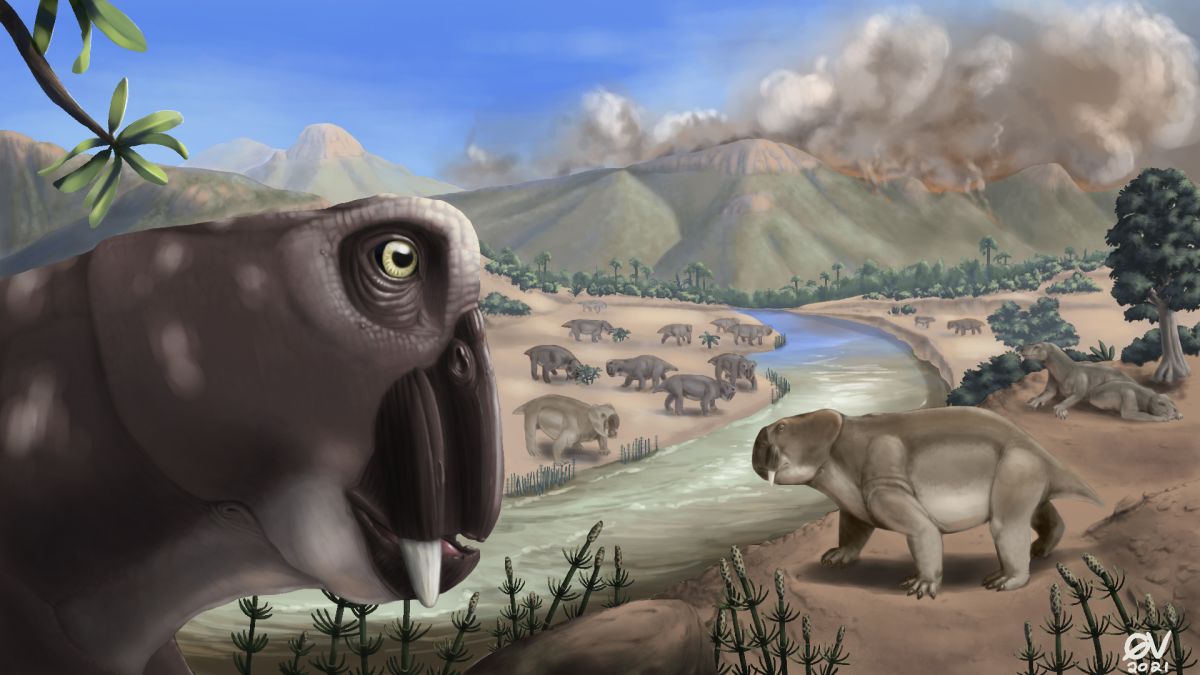About 251 million years ago, groups of pig-size herbivores with tusks and beaks huddled together, died, shriveled up and then fossilized looking like squashed roadkill, with impressions of their pebbly skin still present in the rocks around them.
These strange layers of fossils suggest that recurring drought was a big problem for the animals, which were members of the genus Lystrosaurus, meaning “shovel lizard” in ancient Greek. Lystrosaurs were rare survivors of the Permian-Triassic mass extinction, a period of runaway climate change 252 million years ago that killed an estimated 70% of land vertebrates and 96% of marine animals.
The newly analyzed fossils suggest that Lystrosaurus may have been surviving but not thriving. The climate change that killed off so much of life on Earth likely caused severe droughts on the supercontinent Pangea, which could have caused the deaths of this particular group of animals.
“As we are observing today with global warming, it seems that [warming] increases the likelihood of extreme events,” said Pia Viglietti, a postdoctoral fellow in Earth Sciences at the Field Museum of Natural History in Chicago. “That may have been what was happening in the earliest Triassic, that there were these repeated drought events happening more frequently.”
Live fast, die young
The researchers first found the fossils 11 years ago in the desert Karoo region of South Africa. During an excavation, they unearthed 170 tetrapods, or four-footed animals in about 6.5 feet (2 meters) of sandstone, including multiple clusters of these lystrosaurs. These odd creatures were like no animal alive on Earth today. They were part of a group called therapsids, an extinct order of reptiles that includes mammal ancestors (mammals are the only therapsid descendents that still persist today). They were shaped a bit like a “bulldog with a beak and some tusks,” Viglietti told Live Science.
A photograph of a lystrosaurus fossil found in the field in South Africa. The splayed “roadkill” look is apparent, while the body position and skin impressions suggest these animals died in drought and dried out before being fossilized. (Image credit: Roger Smith) (opens in new tab)
Lystrosaurs were herbivores and probably used their beaks to chew tough vegetation. They seem to have experienced a population boom before and during the end of the Permian, about 252 million years ago. While everything else was busy dying, lystrosaurs were all over the place. But they may not have been living their best lives. The new fossils come from the earliest Triassic, right after the end of the Permian. Most of the dead lystrosaurs were juveniles, which tend to be more susceptible to disasters like droughts, Viglietti said.
Related: The 5 mass extinctions that shaped Earth history
Lystrosaurs might have been dying early immediately after the mass extinction, Viglietti said, and they may have made up for their reduced lifespans by reproducing earlier — a sort of “live fast, die young” way to survive a global cataclysm. (Previous studies have suggested they also slept through it.)
Dying together
The fossils suggest that the young lystrosaurs may have clustered together before they died, probably on a floodplain where they had hope of finding water and vegetation. This sort of behavior is still seen today during droughts in sub-Saharan Africa, Viglietti said, where animals gather around dwindling sources of water and food before succumbing to thirst and starvation.
Face-to-face with a lystrosaurus fossil in the field. The animals seemed to have died in clusters, perhaps indicating they were gathering around shrinking water supplies during a drought. (Image credit: Roger Smith) (opens in new tab)
Two of the fossils found in the Karoo sandstones left skin impressions in the surrounding rock, indicating that the animals may have dried out and mummified rapidly after death, before being buried and fossilized. These two “mummies” were fossilized next to each other, their limbs sprawled out.
“They were both spread-eagled, almost like they had died while going somewhere,” Viglietti said. “Literally stopped in their tracks.”
Lystrosaurs didn’t go extinct for another few million years. The fact that they lived at all when so many other species perished is sometimes held up as evidence that the planet recovered fairly quickly from the climate mess at the end of the Permian, which was caused by huge Siberian volcanoes belching gasses into the atmosphere. But the discovery of a population struggling under the stress of repeated droughts suggests that Earthdidn’t recover quickly at all, Viglietti said.
This finding gives an insight into how Earth could react to the current climate crisis, Viglietti added.
“If we don’t mitigate our climate crisis, things won’t just bounce back, not even within the lifetime of our species or possibly other species that follow us,” Viglietti said. “Recovery from these events can take a long time.”
The findings are in press in the journal Palaeogeography, Palaeoclimatology, Palaeoecology.
Originally published on Live Science.
































